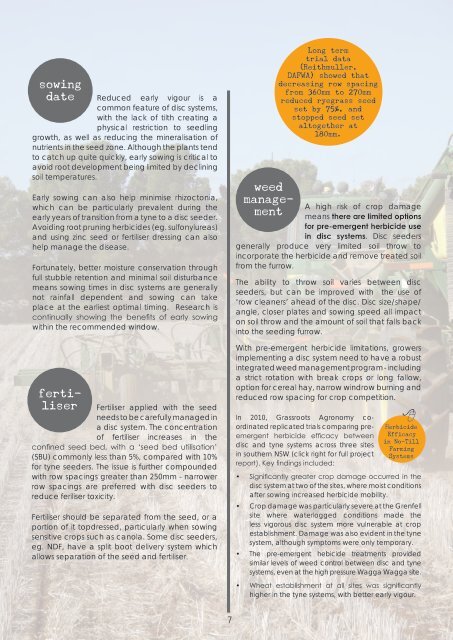Create successful ePaper yourself
Turn your PDF publications into a flip-book with our unique Google optimized e-Paper software.
sowing<br />
date Reduced early vigour is a<br />
common feature of <strong>disc</strong> systems,<br />
with the lack of tilth creating a<br />
physical restriction to seedling<br />
growth, as well as reducing the mineralisation of<br />
nutrients in the seed zone. Although the plants tend<br />
to catch up quite quickly, early sowing is critical to<br />
avoid root development being limited by declining<br />
soil temperatures.<br />
Early sowing can also help minimise rhizoctonia,<br />
which can be particularly prevalent during the<br />
early years of transition from a tyne to a <strong>disc</strong> seeder.<br />
Avoiding root pruning herbicides (eg. sulfonylureas)<br />
and using zinc seed or fertiliser dressing can also<br />
help manage the disease.<br />
Fortunately, better moisture conservation through<br />
full stubble retention and minimal soil disturbance<br />
means sowing times in <strong>disc</strong> systems are generally<br />
not rainfall dependent and sowing can take<br />
place at the earliest optimal timing. Research is<br />
continually showing the benefits of early sowing<br />
within the recommended window.<br />
weed<br />
management<br />
fertiliser<br />
Fertiliser applied with the seed<br />
needs to be carefully managed in<br />
a <strong>disc</strong> system. The concentration<br />
of fertiliser increases in the<br />
confined seed bed, with a ‘seed bed utilisation’<br />
(SBU) commonly less than 5%, compared with 10%<br />
for tyne seeders. The issue is further compounded<br />
with row spacings greater than 250mm - narrower<br />
row spacings are preferred with <strong>disc</strong> seeders to<br />
reduce feriliser toxicity.<br />
Fertiliser should be separated from the seed, or a<br />
portion of it topdressed, particularly when sowing<br />
sensitive crops such as canola. Some <strong>disc</strong> seeders,<br />
eg. NDF, have a split boot delivery system which<br />
allows separation of the seed and fertiliser.<br />
Long term<br />
trial data<br />
(Reithmuller,<br />
DAFWA) showed that<br />
decreasing row spacing<br />
from 360mm to 270mm<br />
reduced ryegrass seed<br />
set by 75%, and<br />
stopped seed set<br />
altogether at<br />
180mm.<br />
A high risk of crop damage<br />
means there are limited options<br />
for pre-emergent herbicide use<br />
in <strong>disc</strong> systems. Disc seeders<br />
generally produce very limited soil throw to<br />
incorporate the herbicide and remove treated soil<br />
from the furrow.<br />
The ability to throw soil varies between <strong>disc</strong><br />
seeders, but can be improved with the use of<br />
‘row cleaners’ ahead of the <strong>disc</strong>. Disc size/shape/<br />
angle, closer plates and sowing speed all impact<br />
on soil throw and the amount of soil that falls back<br />
into the seeding furrow.<br />
With pre-emergent herbicide limitations, growers<br />
implementing a <strong>disc</strong> system need to have a robust<br />
integrated weed management program - including<br />
a strict rotation with break crops or long fallow,<br />
option for cereal hay, narrow windrow burning and<br />
reduced row spacing for crop competition.<br />
In 2010, Grassroots Agronomy coordinated<br />
replicated trials comparing preemergent<br />
herbicide efficacy between<br />
<strong>disc</strong> and tyne systems across three sites<br />
in southern NSW (click right for full project<br />
report). Key findings included:<br />
<br />
Herbicide<br />
Eff’icacy<br />
in No-Till<br />
Farming<br />
Systems<br />
• Significantly greater crop damage occurred in the<br />
<strong>disc</strong> system at two of the sites, where moist conditions<br />
after sowing increased herbicide mobility.<br />
• Crop damage was particularly severe at the Grenfell<br />
site where waterlogged conditions made the<br />
less vigorous <strong>disc</strong> system more vulnerable at crop<br />
establishment. Damage was also evident in the tyne<br />
system, although symptoms were only temporary.<br />
• The pre-emergent hebicide treatments provided<br />
similar levels of weed control between <strong>disc</strong> and tyne<br />
systems, even at the high pressure Wagga Wagga site.<br />
• Wheat establishment at all sites was significantly<br />
higher in the tyne systems, with better early vigour.<br />
7


